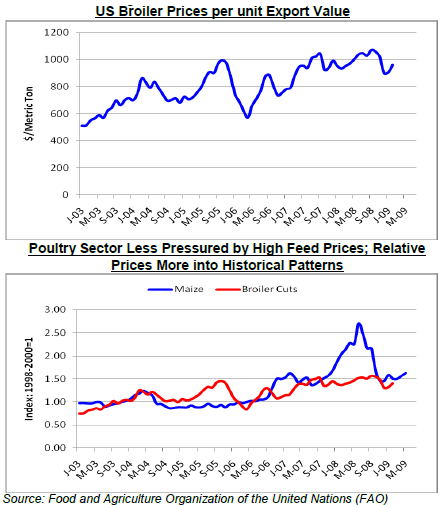



International Egg and Poultry Review
GLOBAL - By the USDA's Agricultural Marketing Service (AMS). This is a weekly report looking at international developments concerning the poultry industry. This week's report covers the poultry outlook around the globe.June 2009 FAO Food Outlook: International Meat Prices Fall along with Weakening Demand
World
The outlook on world poultry meat production was adjusted down to 94.7 million tons since November 2008 mostly due to avian influenza outbreaks in Asia. Global poultry meat production is forecast to increase by a mere 1 per cent from 2008, one of the slowest growth rates of the decade. Despite lower feed costs in relation to that of poultry meat in the last quarter of 2008, consumer demand faltered in early 2009 reversing the relationship and indicating another year of low profits or even losses.
World poultry trade was revised downward and is expected to decline 3 per cent in 2009 to just over 10 million tons despite relatively lower poultry meat prices in comparison to other proteins. Regarding imports, the forecasted reductions in poultry trade are attributed to lower shipments to China, Russia, and the Ukraine. Imports levels to the Ukraine would actually return to normal levels after exceptionally high import levels in 2008.
Increased meat prices in 2008 provided producers a temporary break from constant profit margin declines over the last few years. New data suggests profitability in 2009 is again declining due to the steady deterioration of international meat prices since hitting peak levels in October 2008. Though international meat prices appear to be showing signs of stabilization they have not yet returned to levels seen in the early 2007. The declines affected the bovine, ovine, and poultry meat sectors hardest. The fall in international meat prices reflects the deteriorating global economic environment’s impact on consumption growth and demand, especially in the developed countries.
Asia
Most of Asia’s poultry meat production is expected to increase. However China, whose poultry meat consumption has been fueled in recent years by its increased purchasing power provided mostly by its urban population, which has currently been struggling under the pressure of the ongoing international financial crisis, is now projected to decrease its poultry meat production by about 3 per cent due to the expected sluggish domestic demand. Despite rising debts from high feed costs, poultry meat production in India, Indonesia, the Islamic Republic of Iran, and Thailand appears strong. Poultry production is expected to increase 6 per cent in Thailand and 5 per cent in Indonesia.
North America
Wholesale broiler prices increased in early 2009 due to sustained demand coupled with tight supplies, which were constrained by high costs. Despite this, early indications in the first half of 2009 suggest poultry production could drop 3 per cent to 19.3 million tons from 2008. US poultry exports are expected to taper to volumes seen in 2007 following reduced profit margins and lower import quotas imposed by Russia.

Europe
Russia’s poultry meat production is projected to decline to 9 per cent, much weaker than the above average growth levels of 16 per cent it has been experiencing recently. However little change is expected in the European Union (EU) as poultry exports are projected to be impacted by Russia’s quota reductions and face SPS challenges at the plant level.
South America
Brazilian poultry production is forecast to increase 2 per cent in 2009 as farmers are encouraged by the Brazilian Association of Poultry Exporters (ABEF) to reduce production for export in light of the world market situation. Brazilian poultry export growth is forecast to drop due to reduced credit availability, voluntary export restrictions, and suspended exports to China in early 2008 when doubts were raised regarding product origin in a registered firm, which the US helped cover. However discussions are underway between Brazil and China to set up inspection and guarantee procedures that could help lift these restrictions. Should the ban be suspended, the US would once again face Brazilian competition in the Chinese market.
Africa
In recent months, farmers in Kenya, Nigeria, and Uganda have been struggling with higher feed costs, delayed and insufficient loans, and concerns have been raised about perceived egg shortages in local markets. On the other hand, South Africa’s industry has shown signs of recovery in early 2009 after a difficult 2008 and is expected to have poultry production increases of 5 per cent in 2009.
Source: June 2009 Food Outlook by Food and Agriculture Organization of the United Nations (FAO)

Further Reading
| - | You can view the full report by clicking here. |











